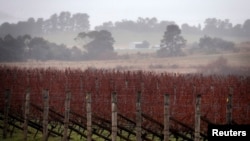Wildfires sweeping through southeast Australia are carrying with them the specter of a silent killer for grapes growing in the nearby Adelaide Hills wine region.
The vineyards have so far escaped the direct ravages of the worst bushfires in 30 years but winemakers fear their grapes may have fallen victim to “smoke taint,” which results in wines that taste like an ashtray and can ruin an entire vintage.
As fears grow that climate change is lengthening the time and severity of Australia's bushfire season, government funding to find a solution to the phenomenon is drying up.
'Nightmare of a problem'
“It's a nightmare of a problem,” said Mark Krstic, a specialist in smoke taint at the Australian Wine Research Institute who is liaising with worried growers in the Adelaide Hills in South Australia state.
“Smoke taint is one of the symptoms of climate change for the wine industry and it's only getting worse,” he said.
Smoke taint first caught the industry's attention when Victoria state's severe bushfires in 2003 cost grape growers more than 7.5 million Australian dollars (U.S. $6.05 million) in lost vintages. Since then, it has recurred in vintages around the country in four other years.
The contamination occurs when smoke compounds enter vines through the stomata - the minute pores in the epidermis of the leaf - and are transported into grape skins.
Those compounds are then released into the wine when the crushed grapes come into contact with the skins during fermentation. Tasters commonly liken the resulting wine to an ashtray, burnt rubber and hospital disinfectant.
Grape growers with tainted crops have two options – abandon the vintage or continue the costly harvesting and fermentation process to make a significantly devalued product.
“It's a no-win,” said Chris Pfieffer of Pfieffer Wines in the Rutherglen wine region, who lost his 2003 crop to smoke taint. “It's a risk that's at the top of climate change concerns in the industry.”
Hotter and drier
Australia's main wine growing regions are growing ever hotter and drier, with temperatures projected to increase by between 0.3 and 1.7 degrees Celsius by 2030, according to the CSIRO, Australia's national science agency.
That has prompted many major growers such as Treasury Wine Estates to look for cooler climate vineyards in places like the southernmost island state of Tasmania.
There are also mitigation measures in place to deal with some of the warming effects, such as new irrigation methods and specially developed sunscreen for grapes.
But attempts to find a way to extract the smoke taint compound have so far failed and the industry is concerned about a lack of public money for research into the problem.
There are no funds from Australia's current Conservative-led coalition government, which has played down the role of climate change on agriculture. A $4 million project over four years run by the Victoria government, the only assistance at state level, ends in the middle of 2015.
Hard to detect
A complicating factor for growers is that smoke taint is not immediately detectable. Samples of suspected contaminated grapes cannot be taken for clinical testing and a mini-fermentation to determine taste until a couple of weeks before normal harvest time. That can mean an agonizing wait of weeks or months for growers who think they may have affected vines.
Worse, as young wines mature, the smoke taint can develop further as the guilty compounds continue to break down.
That risk means many wine makers like Treasury and Australian Vintage have in recent years inserted blanket clauses in their contracts with growers saying they reserve the right to reject the grapes if there is any sign of smoke taint, no matter how mild.
Chris Pfieffer chose to harvest his 2003 crop “to the ground” and forgo the cost of fermenting. Pfieffer's grapes were infected again to differing degrees in 2007, 2009, 2010 and 2013.
While a grape grower can command between $3 and $4 a liter for good quality grapes, that falls to just 50 to 60 cents a liter for the bulk sale of partially smoke-tainted grapes. If the grapes are so badly affected they can only be distilled to recover the alcohol, the price falls to around 10 cents per liter.
Those reduced returns line up against the $2 per liter average cost to grow grapes.
“I chose not to work that out,” Pfieffer said when asked about the accumulated financial toll. “If you do that in the wine industry, you'd end up crying, but it's certainly significant.”
Concerned growers in the Adelaide Hills, many of whom have been evacuated as the current fires rage, are meeting with the AWRC's Krstic next week to consider their options.
“Wine may ultimately be seen as too much of a luxury,” Pfieffer said. “We might be better off using our water to grow lettuces.”






